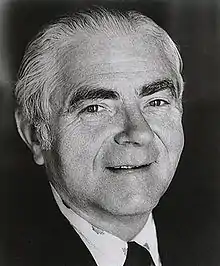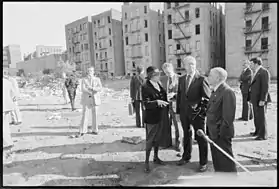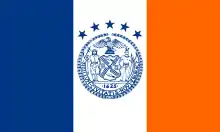Abraham Beame
Abraham David Beame (March 20, 1906 – February 10, 2001)[2] was the 104th Mayor of New York City from 1974 to 1977.[3] As mayor, he presided over the city during its fiscal crisis of the mid-1970s, when the city was almost forced to declare bankruptcy.
Abraham Beame | |
|---|---|
 | |
| 104th Mayor of New York City[1] | |
| In office January 1, 1974 – December 31, 1977 | |
| Preceded by | John V. Lindsay |
| Succeeded by | Ed Koch |
| 36th and 38th New York City Comptroller | |
| In office January 1, 1970 – December 31, 1973 | |
| Mayor | John V. Lindsay |
| Preceded by | Mario Procaccino |
| Succeeded by | Harrison J. Goldin |
| In office January 1, 1962 – December 31, 1965 | |
| Mayor | Robert F. Wagner, Jr. |
| Preceded by | Lawrence E. Gerosa |
| Succeeded by | Mario Procaccino |
| Personal details | |
| Born | Abraham David Birnbaum March 20, 1906 London, England, UK |
| Died | February 10, 2001 (aged 94) New York City, New York, U.S. |
| Political party | Democratic |
| Spouse(s) | Mary Ingerman
(m. 1928; died 1995) |
| Children | 2 |
| Alma mater | Baruch College (degree originally conferred by the City College of New York) |
| Profession | Accountant |
Early life
Beame was born Abraham David Birnbaum in London.[4] His parents were Esther (née Goldfarb) and Philip Birnbaum, Jewish immigrants from Poland who fled Warsaw.[5][6] Beame and his family left England when he was three months old.[5] He was raised on New York City's Lower East Side.
He graduated from P.S. 160 and the High School of Commerce before enrolling at the City College of New York's School of Business and Civic Administration (later spun off as Baruch College), where he received his undergraduate degree in business with honors in 1928.[4][5][6]
Career
Career before politics
While in college, he co-founded an accounting firm, Beame & Greidinger.[5] He was an accounting teacher at Richmond Hill High School in Queens from 1929 to 1946[6] and also taught accounting and commercial law at Rutgers University from 1944 to 1945.
From 1952 to 1961, he served as New York City's Director of the Budget, having also served as Assistant Director from 1946 to 1952.[5] In this capacity, he "he negotiated all city labor contracts without a strike and kept books on city spending and borrowing; he also set up management programs that saved the city $40 million."[2]
Early political career
Beame was a "clubhouse" or machine politician, a product of the Brooklyn wing of the patronage-oriented "regular" Democratic organization (the borough's equivalent of Manhattan's Tammany Hall and the locus of New York patronage politics following the ascent of Meade Esposito) as opposed to the policy-oriented "reform" Democrats who entered New York City politics (most effectively in Manhattan and the Bronx) in the 1950s.
Prior to being elected to two nonconsecutive terms as city comptroller in 1961 and 1969, he was a longstanding member of Crown Heights' influential Madison Democratic Club and retained as the personal accountant of political boss Irwin Steingut. Members of the Madison Club (including attorney/fundraiser Abraham "Bunny" Lindenbaum and Steingut's son, Stanley) frequently liaised with developer Fred Trump. The organization also played a decisive role in the political ascent of Park Slope-based attorney Hugh Carey, who served as Governor of New York during Beame's administration, although Carey would eventually break with the organization by endorsing Mario Cuomo's 1977 primary bid to unseat Beame.[7][8]
In 1965, he was the Democratic nominee for Mayor but was defeated by then-Republican John V. Lindsay.[9]
Mayor of New York City

Beame defeated State Senator John J. Marchi in the 1973 mayoral election, becoming the 104th Mayor of New York City.[4] He faced the worst fiscal crisis in the city's history and spent the bulk of his term attempting to ward off bankruptcy.
He slashed the city workforce, froze salaries, and reconfigured the budget, which proved unsatisfactory until reinforced by actions from newly created state-sponsored entities and the granting of federal funds. However, "he was credited with distributing the City's dwindling resources equitably".[3] When he left office on New Year's Day 1978, the city budget had changed from a $1.5 billion deficit[5] to a surplus of $200 million.[4]
In October 1975, the city of New York was in debt of four hundred and fifty-three million dollars. Beame made a statement on October 17, notifying that the city has insufficient cash on hand to meet the debt obligations due for that day. Beame goes on to say that we (citizens of New York City) need to take immediate steps to protect the essential life support systems of the city and to preserve the well-being of all NYC citizens. President Ford at first turned down New York's request for a loan, inspiring the legendary headline in the Daily News, "Ford to City: Drop Dead." However, President Ford would later approve federal support for New York.[10]
On July 13, 1977, a massive power failure hit New York City and its boroughs. With temperatures in the mid-nineties and the humidity high, New Yorkers sweltered, and, before power was restored at 10:39 p.m. on the following evening, the city was without power for more than twenty-five hours. Mayor Abraham Beame set up a Blackout Action Center at the headquarters of the New York City Police Department. The blackout resulted in raw sewage washing up on beaches and spoiled foods in hundreds, if not thousands of restaurants around the city, [11]
After a chaotic four years as mayor, Beame ran for a second term in 1977, and finished third in the Democratic primary, behind Representative Ed Koch and New York Secretary of State Mario Cuomo, and ahead of former Representative Bella Abzug, Representative Herman Badillo and Manhattan Borough President Percy Sutton. He was succeeded by Koch, who won the general election on November 8, 1977.[5]
Beame was the first mayor of New York City who was a practicing Jew.[6] (Fiorello La Guardia, who was mayor from 1934 to 1945, was halachically Jewish because his mother was born Jewish, but was raised as an Episcopalian and practiced that religion all his life.)
Personal life
Beame was 5 ft 2 (157 cm) tall.[12]
He was married to his childhood sweetheart, Mary (née Ingerman),[5] for 67 years.[4] They raised two sons, Edmond and Bernard (Buddy),[2][5] and resided in Brooklyn, first in Crown Heights and later in a "modest apartment" on Plaza Street West in Park Slope.[4][13] Throughout his life, he summered in the Rockaway neighborhood of Belle Harbor.[4]
Beame was a recipient of the Townsend Harris medal, 1957, Man of Yr. awards numerous charitable, religious and civic organizations. [14]
Death
Beame died at the age of 94 on February 10, 2001—just two months after the death of his predecessor, Lindsay—after open-heart surgery at New York University Medical Center.[2]
References
- "The Green Book: Mayors of the City of New York". NYC.gov. May 14, 2012. Archived from the original on May 14, 2012. on the official NYC website
- McFadden, Robert D. (February 11, 2001). "Abraham Beame Is Dead at 94; Mayor During 70's Fiscal Crisis". The New York Times. p. 1. Retrieved March 18, 2010.
Abraham D. Beame, an accountant and clubhouse Democrat who climbed the gray ranks of municipal bookkeeping and confounded oddsmakers to become mayor of New York in the mid-1970s, only to spend his term struggling with the worst fiscal calamity in the city's history, died yesterday at New York University Medical Center in Manhattan. He was 94.
- "Parks Remembers Mayor Beame". Daily Plant. New York City Department of Parks & Recreation. XVI (3304). February 16, 2001. Retrieved March 23, 2016.
- Giuliani, Rudolph W. "Remarks at the Funeral Service for Mayor Abraham Beame". nyc.gov.
- Marks, Jason. "12 Who Made It Big: Abraham D. Beame '28". History of Baruch College. Baruch College, City University of New York. Archived from the original on April 12, 2016. Retrieved March 23, 2016.
- "New York City's first Jewish mayor". Richmond Hill Historical Society. Retrieved March 23, 2016.
- Lichtenstein, Grace (November 8, 1974). "Madison Democratic Club Brings Influence to Brooklyn (Published 1974)" – via NYTimes.com.
- Pérez-Peña, Richard (August 7, 2011). "Hugh Carey, Who Led Fiscal Rescue of New York City, Is Dead at 92 (Published 2011)" – via NYTimes.com.
- Witkin, RIchard (November 3, 1965). "Lindsay Beats Beame In A Close Race; O'Connor and Procaccino Both Win; State Senate Is G.O.P.; Hughes Victor - Seesaw Contest - Vote Is Tightest Here in Quarter Century - 13% for Buckley". The New York Times. p. 1. Retrieved August 18, 2016.
- Nussbaum, Jeff (October 16, 2015). "The Night New York Saved Itself From Bankruptcy". The New Yorker. Retrieved December 7, 2020.
- Imperato, Pascal (August 1, 2016). "Public Health Concerns Associated with the New York City Blackout of 1977". Journal of Community Health. 41: 707–716 – via JSTOR.
- Sewell, Chan (December 4, 2006). "The Mayor's Tall Tales". The New York Times.
- "2006 – Historical notes on Carroll Gardens, Brooklyn Heights, Cobble Hill, Flatbush, etc". Issuu.
- "Beame, Abraham David former mayor". Salem Press Encyclopedia. January 1, 2016 – via JSTOR.
External links
- "Abraham D. Beame Collection". La Guardia and Wagner Archives.
- "Oral history Guides: Abraham D. Beame". Columbia University.
- Abraham Beame at Find a Grave
| Political offices | ||
|---|---|---|
| Preceded by Lawrence E. Gerosa |
New York City Comptroller 1962–1965 |
Succeeded by Mario Procaccino |
| Preceded by Mario Procaccino |
New York City Comptroller 1970–1973 |
Succeeded by Harrison J. Goldin |
| Preceded by John V. Lindsay |
Mayor of New York City 1974–1977 |
Succeeded by Edward I. Koch |
| Party political offices | ||
| Preceded by Robert F. Wagner, Jr. |
Democratic Nominee for Mayor of New York City 1965 |
Succeeded by Mario Procaccino |
| Preceded by Mario Procaccino |
Democratic Nominee for Mayor of New York City 1973 |
Succeeded by Edward I. Koch |
